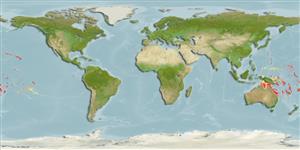Common names from other countries
>
Eupercaria/misc (Various families in series Eupercaria) >
Scaridae (Parrotfishes) > Scarinae
Etymology: Scarus: Greek, skaros = a fish described by anciente writers as a parrot fish; 1601 (Ref. 45335).
More on author: Steindachner.
Environment: milieu / climate zone / depth range / distribution range
экология
морской ассоциированный с рифами; пределы глубины 1 - 50 m (Ref. 37816). Tropical; 32°N - 32°S, 132°E - 124°W
Pacific Ocean: Ryukyu Island to the Line and Ducie Islands, north to southern Japan, south to Lord Howe and Rapa Islands; throughout Micronesia.
Size / Вес / Возраст
Maturity: Lm ? range ? - ? cm
Max length : 60.0 cm TL самец/пол неопределен; (Ref. 9710); common length : 41.0 cm SL самец/пол неопределен; (Ref. 37816)
Краткое описание
определительные ключи | морфология | морфометрия
колючие лучи спинного плавника (общее число) : 9; членистые (мягкие) лучи спинного плавника (общее число) : 10; колючие лучи анального плавника: 3; членистые (мягкие) лучи анального плавника: 9. This is the only Scarus in which one of the middle dorsal rays of terminal males is produced into a slightly elongate filament. Small juveniles have a distinctive yellow head and striped to mottled body (Ref. 1602).
Often found in large groups (Ref. 90102). Adults usually seen along the reef margin of seaward reefs while juveniles and subadults are found in shallow protected reefs (Ref. 9710). Feeds mainly on algae (Ref. 26993). Occurs to a depth of over 50 m (Ref. 1602). Adults and subadults form groups, juveniles usually solitary (Ref. 9710). Minimum depth of 1 m reported from Ref. 90102.
Life cycle and mating behavior
Maturities | размножение | Spawnings | Egg(s) | Fecundities | личинки
Oviparous, distinct pairing during breeding (Ref. 205).
Parenti, P. and J.E. Randall, 2000. An annotated checklist of the species of the labroid fish families Labridae and Scaridae. Ichthyol. Bull. J.L.B. Smith Inst. Ichthyol. (68):1-97. (Ref. 35918)
Статус Красного Списка МСОП (Ref. 130435)
CITES (Ref. 128078)
Not Evaluated
Угроза для людей
Reports of ciguatera poisoning (Ref. 130160)
Использование человеком
дополнительная информация
инструменты
Специальные отчеты
Скачать в формате XML
ресурсы в Интернет
Estimates based on models
Preferred temperature (Ref.
115969): 24.5 - 28, mean 26.7 (based on 134 cells).
Phylogenetic diversity index (Ref.
82804): PD
50 = 0.5000 [Uniqueness, from 0.5 = low to 2.0 = high].
Bayesian length-weight: a=0.01413 (0.01160 - 0.01720), b=3.03 (2.99 - 3.07), in cm Total Length, based on LWR estimates for this species (Ref.
93245).
Trophic level (Ref.
69278): 2.0 ±0.00 se; based on food items.
устойчивость к внешним воздействиям (Ref.
120179): низкий, минимальное время удвоения популяции 4.5-14 лет (K=0.25; tmax=13).
Fishing Vulnerability (Ref.
59153): Low to moderate vulnerability (27 of 100).
